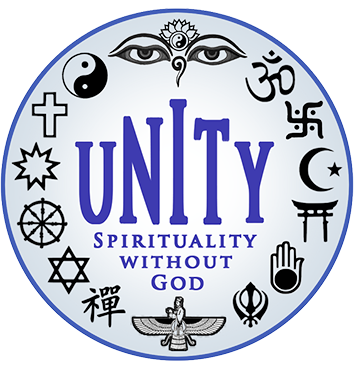
One of my favourite aphorisms is from Douglas Adams, author of The Hitchhiker's Guide to the Galaxy ...
"I am fascinated by religions,
I'm just stumped people take them seriously."
You may agree with that sentiment or not, but in case you do find religions fascinating (as I obviously do), go to this Wikipedia page and knock yourself out ... I had absolutely no idea just how many beliefs there are in the world; I hardly scratch the surface with that dozen or so I am listing here. Amazing ... there is even "Chrislam", a neologism used to refer to syncretism between Christianity and Islam among the Yoruba of Nigeria.
At the bottom of this page I make reference to Confucianism ... since it's not a religion (though called that by some) it indeed is a philosophy I like a lot; I often refer to the teachings ascribed to Confucius ... here is a collection of Confucian Quotes. In fact my favourite line that forms the lead-in to my book harks back to Confucius:
"There is only one problem in the world:
People don’t recognize reality and once
confronted with it, they can’t deal with it."
The reason why Confucianism resonates with me is that it is described as a philosophy, a humanistic or rationalistic way of governing or simply a way of life. I have an essay CONFUCIANISM in my book en.light.en.ment

_________________________________________
Furthermore to the religions examined below, I still have some attachment to Sant Mat and the Master, Guru Maharaj Charan Singh Ji. I do not anymore call myself a follower; indeed, since I studied Krishnamurti I can say I am not a follower of anyone or anything. But I owe a gratitude to the Master for my awakening.

I was attracted to the concept of a living Master, as opposed to a deity or a long dead authority figure. The reason I diverted from the Sant Mat path is that while I first deemed it largely a secular philosophy, I soon realised the teachings are deeply steeped in a belief in God. In the end this did not agree with my beliefs.
_________________________________________
On this Patheos page you'll find an in-depth summary of world religions:

_________________________________________
This is a glossary for the religious symbols in my UNITY logo; from the top:
the following largely courtesy of Wikipedia
When a person awakes (represented by eyes of wisdom and compassion)
from the bonds of the world, the person reaches the state of enlightenment.
Swayambhu is an ancient religious architecture atop a hill in the Kathmandu Valley, west of Kathmandu city. The Tibetan name for the site means 'Sublime Trees', for the many varieties of trees found on the hill. However, Shing.kun may be a corruption of the local Nepal Bhasa name for the complex, Singgu, meaning 'self-sprung'. For the Buddhist Newars in whose mythological history and origin myth as well as day-to-day religious practice, Swayambhu occupies a central position, it is probably the most sacred among Buddhist pilgrimage sites. For Tibetans and followers of Tibetan Buddhism, it is second only to Boudha.

I took this photo in 1972
on my 'Great Journey' to Nepal & India
Hinduism is a religion, or a way of life, found most notably in India and Nepal. Hinduism has been called the oldest religion in the world, and some practitioners and scholars refer to it as Sanātana Dharma, "the eternal law," or the "eternal way," beyond human origins. Scholars regard Hinduism as a fusion or synthesis of various Indian cultures and traditions, with diverse roots and no founder. This "Hindu synthesis" started to develop between 500 BCE and 300 CE following the Vedic period (1500 BCE to 500 BCE).
Swastika (also known outside the Indian subcontinent as the Hakenkreuz, gammadion cross, cross cramponnée, croix gammée, fylfot, or tetraskelion) (as a character 卐 or 卍) is an ancient religious symbol originating from the Indian subcontinent, that generally takes the form of an equilateral cross with four legs each bent at 90 degrees. It is considered to be a sacred and auspicious symbol in Hinduism, Buddhism, and Jainism and dates back 11,000 years.

Islam is an Abrahamic monotheistic religion which professes that there is only one and incomparable God (Allah), that Muhammad is the last messenger of God, and that submission to God is the means to get eternal salvation. It is the world's second-largest religion and the fastest-growing major religion in the world, with over 1.7 billion followers or 23% of the global population, known as Muslims. Islam teaches that God is merciful, all-powerful, and unique; and He has guided mankind through revealed scriptures, natural signs, and a line of prophets sealed by Muhammad. The primary scriptures of Islam are the Quran, traditionally viewed as the verbatim word of God, and the Hadith, which reports the sayings and normative behavior of Muhammad (c. 570–8 June 632 CE).
Shinto is a Japanese ethnic religion. It focuses on ritual practices to be carried out diligently, to establish a connection between present-day Japan and its ancient past. Shinto practices were first recorded and codified in the written historical records in the 8th century. Still, these earliest Japanese writings do not refer to a unified "Shinto religion", but rather to a collection of native beliefs and mythology. Shinto today is a term that applies to the religion of public shrines devoted to the worship of a multitude of gods, suited to various purposes such as war memorials and harvest festivals, and applies as well to various sectarian organizations. Practitioners express their diverse beliefs through a standard language and practice, adopting a similar style in dress and ritual, dating from around the time of the Nara and Heian periods (8th to 12th centuries AD).

Jainism, traditionally known as Jain Dharma, is an ancient Indian religion belonging to the śramaṇa tradition. The central tenet is non-violence and respect towards all living beings. The three main principles of Jainism are ahimsa (non-violence), anekantavada (non-absolutism) and aparigraha (non-possessiveness). Followers of Jainism take five main vows: ahimsa (non-violence), satya (not lying), asteya (not stealing), brahmacharya (chastity) and aparigraha (non-attachment). Jain monks and nuns observe these vows absolutely whereas householders (śrāvakas) observe them within their practical limitations. Self-discipline and asceticism are thus major focuses of Jainism. Notably, Mahatma Gandhi was greatly influenced by Jainism and adopted many Jain principles in his life.

Sikhism, from Sikh, meaning a "disciple" or a "learner", is a panentheistic religion that originated in the Punjab region of India during the 15th century. It is one of the youngest of the major world religions. The fundamental beliefs of Sikhism, articulated in the sacred scripture Guru Granth Sahib, include faith and meditation on the name of the one creator, unity of all humankind, engaging in selfless service, striving for social justice for the benefit and prosperity of all, and honest conduct and livelihood while living a householder's life. Sikhism has 25-28 million adherents worldwide and is the ninth-largest religion in the world.
the wings symbolise the soul, before birth and after death
Zoroastrianism, is one of the world's oldest religions, combining a cosmogonic dualism and eschatological monotheism in a manner unique among the major religions of the world. Ascribed to the teachings of the Iranian prophet Zoroaster (or Zarathustra), it exalts a deity of wisdom, Ahura Mazda (Wise Lord), as its Supreme Being. Major features of Zoroastrianism, such as messianism, heaven and hell, and free will have, some believe, influenced other religious systems, including Second Temple Judaism, Gnosticism, Christianity, and Islam. With possible roots dating back to the second millennium BCE, Zoroastrianism enters recorded history in the 5th-century BCE, and served as the state religion of the pre-Islamic Iranian empires from around 600 BCE to 650 CE. Zoroastrianism was suppressed from the 7th century onwards following the Muslim conquest of Persia of 633-654. Recent estimates place the current number of Zoroastrians at around 2.6 million, with most living in India and in Iran.

Zen is a school of Mahayana Buddhism that originated in China during the Tang dynasty as Chan Buddhism. The Zen school was strongly influenced by Taoism and developed as a distinguished school of Chinese Buddhism. From China, Chan Buddhism spread south to Vietnam, northeast to Korea and east to Japan, where it became known as Japanese Zen. The term Zen is derived from the Japanese pronunciation of the Middle Chinese word 禪 (Chan) which traces its roots to the Indian practice of Dhyana ("meditation"). Zen emphasizes rigorous self-control, meditation-practice, insight into Buddha-nature, and the personal expression of this insight in daily life, especially for the benefit of others. As such, it de-emphasizes mere knowledge of sutras and doctrine and favors direct understanding through zazen and interaction with an accomplished teacher. The teachings of Zen include various sources of Mahayana thought, especially Yogachara, the Tathāgatagarbha sūtras and the Huayan school, with their emphasis on Buddha-nature, totality, and the Bodhisattva-ideal. The Prajñāpāramitā literature and, to a lesser extent, Madhyamaka have also been influential in the shaping of the "paradoxical language" of the Zen-tradition.

Judaism (from Latin: Iudaismus, derived from Greek Ἰουδαϊσμός, originally from Hebrew יהודה, Yehudah, "Judah"; in Hebrew: יהדות, Yahadut, the distinctive characteristics of the Judean ethnos) encompasses the religion, philosophy, culture and way of life of the Jewish people. Judaism is an ancient monotheistic religion, with the Torah as its foundational text (part of the larger text known as the Tanakh or Hebrew Bible), and supplemental oral tradition represented by later texts such as the Midrash and the Talmud. Judaism is considered by religious Jews to be the expression of the covenantal relationship that God established with the Children of Israel. With between 14.5 and 17.4 million adherents worldwide, Judaism is the tenth-largest religion in the world.

Buddhism is a religion and dharma that encompasses a variety of traditions, beliefs and spiritual practices largely based on teachings attributed to the Buddha. Buddhism originated in India sometime between the 6th and 4th centuries BCE, from where it spread through much of Asia, whereafter it declined in India during the middle ages. Two major extant branches of Buddhism are generally recognized by scholars: Theravada (Pali: "The School of the Elders") and Mahayana (Sanskrit: "The Great Vehicle"). Buddhism is the world's fourth-largest religion, with over 500 million followers or 7% of the global population, known as Buddhists.

The Bahá'í Faith is a monotheistic religion which emphasizes the spiritual unity of all humankind. Three core principles establish a basis for Bahá'í teachings and doctrine: the unity of God, that there is only one God who is the source of all creation; the unity of religion, that all major religions have the same spiritual source and come from the same God; and the unity of humanity, that all humans have been created equal, coupled with the unity in diversity, that diversity of race and culture are seen as worthy of appreciation and acceptance. According to the Bahá'í Faith's teachings, the human purpose is to learn to know and to love God through such methods as prayer, reflection, and being of service to humanity.

Christianity is a monotheistic religion based on the life and teachings of Jesus Christ, who serves as the focal point for the religion. It is the world's largest religion, with over 2.4 billion followers, or 33% of the global population, known as Christians. Christians believe that Jesus is the Son of God and the savior of humanity whose coming as the Messiah (the Christ) was prophesied in the Old Testament.
Yin Yang
symbol of Taoism, as well as the symbol for duality
In Chinese philosophy, yin and yang (also yin-yang or yin yang), describe how seemingly opposite or contrary forces may actually be complementary, interconnected, and interdependent in the natural world, and how they may give rise to each other as they interrelate to one another. Many tangible dualities (such as light and dark, fire and water, expanding and contracting) are thought of as physical manifestations of the duality symbolized by yin and yang. This duality lies at the origins of many branches of classical Chinese science and philosophy, as well as being a primary guideline of traditional Chinese medicine, and a central principle of different forms of Chinese martial arts and exercise, such as baguazhang, taijiquan (t'ai chi), and qigong (Chi Kung), as well as appearing in the pages of the I Ching.
Taoism, also known as Daoism, is a religious or philosophical tradition of Chinese origin which emphasizes living in harmony with the Tao ( 道, literally "Way", also romanized as Dao). The Tao is a fundamental idea in most Chinese philosophical schools; in Taoism, however, it denotes the principle that is both the source, pattern and substance of everything that exists. Taoism differs from Confucianism by not emphasizing rigid rituals and social order. Taoist ethics vary depending on the particular school, but in general tend to emphasize wu wei (effortless action), "naturalness", simplicity, spontaneity, and the Three Treasures: jing (sperm/ovary energy, or the essence of the physical body), qi ("matter-energy" or "life force", including the thoughts and emotions), and shén (spirit or generative power).
_________________________________________
There is one philosophy I have not included in my round-up of religions, since it is not really a religion (this actually applies to Buddhism as well) ... Confucianism. However, I use quotes attributed to Confucius in my book and include the article from Wikipedia here. While I know very little about religions and philosophies, I am very partial to the concept of a "way of life" that puts particular emphasis on the importance of the family and social harmony, rather than on an otherworldly source of spiritual values. The core of Confucianism is humanistic.

Confucianism
from Wikipedia
Confucianism, also known as Ruism, is described as a tradition, a philosophy, a religion, a humanistic or rationalistic religion, a way of governing, or simply a way of life. With particular emphasis on the importance of the family and social harmony, rather than on an otherworldly source of spiritual values, the core of Confucianism is humanistic.
According to Herbert Fingarette's concept of "the secular as sacred", Confucianism regards the ordinary activities of human life — and especially in human relationships as a manifestation of the sacred, because they are the expression of our moral nature, which has a transcendent anchorage in Heavenand a proper respect for the spirits or gods. While Tiān has some characteristics that overlap the category of deity, it is primarily an impersonalabsolute principle, like the Dàoor the Brahman. Confucianism focuses on the practical order that is given by a this-worldly awareness of the Tiān.Confucian liturgy led by Confucian priests or "sages of rites" to worship the gods in public and ancestral Chinese temples is preferred in various occasions, by Confucian religious groups and for civil religious rites, over Taoist or popular ritual.
The this-worldly concern of Confucianism rests on the belief that human beings are fundamentally good, and teachable, improvable, and perfectible through personal and communal endeavor especially self-cultivation and self-creation. Confucian thought focuses on the cultivation of virtue and maintenance of ethics. Some of the basic Confucian ethical concepts and practices include "benevolence" or "humaneness" are the essence of the human being which manifests as compassion. It is the virtue-form of Heaven. Yì is the upholding of righteousness and the moral disposition to do good. Lǐ is a system of ritual norms and propriety that determines how a person should properly act in everyday life according to the law of Heaven. Zhì is the ability to see what is right and fair, or the converse, in the behaviors exhibited by others. Confucianism holds one in contempt, either passively or actively, for failure to uphold the cardinal moral values of rén and yì.
Traditionally, cultures and countries in the East Asian cultural sphere are strongly influenced by Confucianism, including mainland China, Taiwan, Hong Kong, Macau, Korea, Japan, and Vietnam, as well as various territories settled predominantly by Chinese people, such as Singapore. In the 20th century Confucianism's influence diminished greatly. In the last decades there have been talks of a "Confucian Revival" in the academic and the scholarly community and there has been a grassroots proliferation of various types of Confucian churches. In late 2015 many Confucian personalities formally established a national Holy Confucian Churchin China to unify the many Confucian congregations and civil society organisations.
Confucianism developed from what was later called the Hundred Schools of Thought from the teachings of the Chinese philosopherConfucius (551–479 BCE), who considered himself a retransmitter of the values of the Zhou dynasty golden age of several centuries before. In the Han dynasty (206 BCE – 220 CE), Confucian approaches edged out the "proto-Taoist" Huang-Lao, as the official ideology while the emperors mixed both with the realist techniques of Legalism. The disintegration of the Han political order in the second century CE opened the way for the doctrines of Buddhism and Neo-Taoism, which offered spiritual explanations lacking in Confucianism.
A Confucian revival began during the Tang dynasty of 618-907. In the late Tang, Confucianism developed in response to Buddhism and Taoism and was reformulated as Neo-Confucianism. This reinvigorated form was adopted as the basis of the imperial exams and the core philosophy of the scholar official class in the Song dynasty (960-1297). The abolition of the examination system in 1905 marked the end of official Confucianism. The New Culture intellectuals of the early twentieth century blamed Confucianism for China's weaknesses. They searched for new doctrines to replace Confucian teachings; some of these new ideologies include the "Three Principles of the People" with the establishment of the Republic of China, and then Maoism under the People's Republic of China. In the late twentieth century Confucian work ethic has been credited with the rise of the East Asian economy.